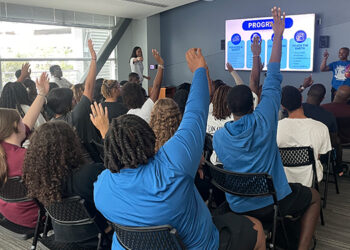In early November 2015, Nicole Mastrocinque, a senior at Stony Brook University was working out at the campus recreation center. She was wearing a T-shirt that she cut the sleeves off, low enough to show skin just past her sports bra. A staff member approached her and told her what she was wearing was inappropriate.
Later in her workout, she noticed a girl in the weight room was working out in a similar shirt, but covered her exposed skin with a bandage because she was also approached. Mastrocinque asked a male, working out in a cut-off T-shirt if a staff member had said anything to him. He said no.
Mastrocinque proceeded to write Jay Souza, the campus recreation director, an emailing detailing a discrepancy in the dress code policy she noticed at the facility.
In response Souza thanked her for her feedback and let her know that the department enforces the policy equally and consistently with both men and women.
Souza started at Stony Brook in 2012. During this time the university was in the process of opening a new recreation center and therefore made modifications to the dress code policy.
“We reviewed a number of policies, just in New York itself,” explained Souza. “Online most places have their policies posted. At Albany, they have shirts that are required at all times. They don’t even allow midriffs, cutoffs, altered shirts. …. Everyone has the no open-toed shoes policy.”
Dress code policy seems to be a point of contention at many universities. Student staff members began telling Laura Munroe, the director of campus recreation at The University of Texas at San Antonio, that they were having a difficult time enforcing the dress code because the rules were vague. When discussing their dress code policy with staff, she said the conversation was all over the place.
“We actually spent, with everyone who is involved with running the facility, probably three or four meetings arguing back and forth,” said Munroe. “Some of our staff actually wanted to say ‘who cares if they have a shirt on at all?’ And then some ‘why don’t we make them all wear a full T-shirt?’ So that’s kind of where we ended up with this one. Because it seemed to be fair for everybody.”
The university allows tank tops, but explained to student staff members that the cut must not go past a fist length, when pressed against his or her armpit. There are posters throughout the facility explaining how to measure the length.
And if a student does violate the dress code policy, instead of kicking them out, Munroe has clothes they can check out for the day.
The University of Baltimore has a dress code policy for each area of their campus recreation policy. “We have a diverse student population here. We have a lot of students coming in to either get a quick workout, want to shoot hoops or a number of different activities they’re trying to get in between classes. We’re also a 100 percent commuter population,” said Nick Owens, the director of student center and recreation programs. “We find a lot of times issues of people didn’t pack their workout clothes or have issues of not having absolutely everything that they need.”
When establishing a dress code policy Munroe recommends including all recreation staff in the conversation. However she cautions, with that many professional staff in one room, be prepared to have to make the final decision. Munroe also encourages directors to think in the eyes of the student.
Owens partnered with other policy makers on campus, stating the dean of students or campus police will back them up on their dress code.
In addition, Souza suggests directors include the students and listen to their feedback. “For instance, we have an advisory board made up of student representatives for the student body and we talk about issues like this. So it’s really a matter of all the feedback. And keep in mind, too, it’s really about providing the best and safest facilities for our students to participate in,”
Mastrocinque ultimately respected the policy at Stony Brook and continues to work out at the facility six days a week, according to The Statesman student newspaper.










